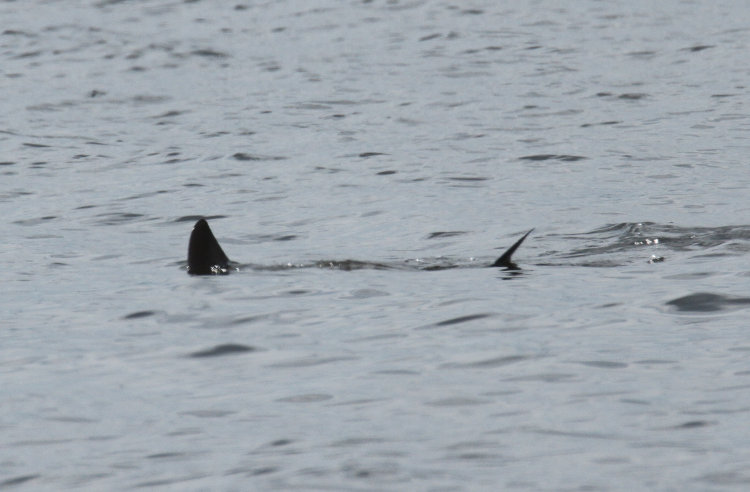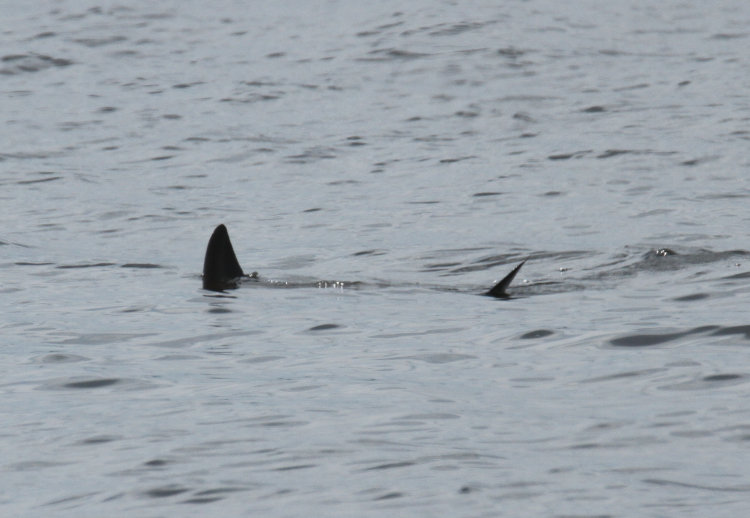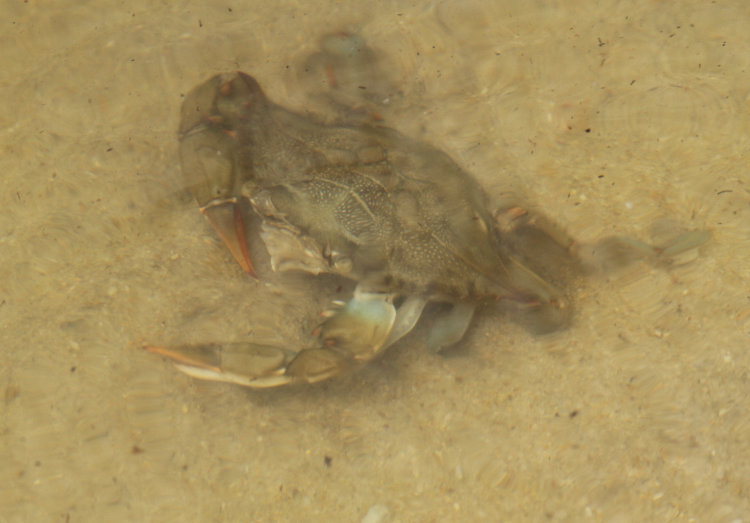I had this one a couple of days ago and purposefully stalled it for the holiday today, which is Is that…? No… Is It? Day, the day when we celebrate the clash between what we think we know and what the evidence is telling us. For this, I present something captured this past Monday while down at Goose Creek State Park.
It was a quiet day, with no sign of either osprey or cormorants and just some lazy seagulls in attendance, at least out over the river. I didn’t stay long because a storm was threatening (imagine that,) but while on the water’s edge, I heard a loud splash behind me, more of a slap! really, but of course all I saw upon turning were the fading ripples from whatever had re-entered the water. As usual, I kept my eye on the spot for a few moments, just in case something else happened, and it did. A couple of fins, ostensibly, broke the surface thrashing gently, disappeared, and repeated this twice more. I had the long lens on so I could snag a few frames, but have no real estimate of size or distance, other than somewhere between 20 and 40 meters away, with the fins extending less than 20cm. The first shot was taken before the lens locked focus.

It’s a crappy shot, and cropped to about half even when at 600mm; I include it as comparison to the next two.

Bear in mind that, between each of these frames, the fins disappeared for a second or three, and each time they were swishing back and forth gently – not disturbing the water too much, but obviously alive and doing something. Nor were they moving laterally at all, at least, not that was discernible, though with the rippling water and no point on the opposite shore to compare them against, I won’t say they were truly fixed.

The thing that gets me is, they look largely the same in all three photos: two fins, facing the same way, angled outwards from each other, protruding the same amount at the same time, roughly the same distance apart. And they’ve got that ‘shark fin’ appearance to them.
Now, I’ve seen tail fins of fish that look like this, especially when you only see half of them, and the Pamlico River is a brackish estuary; this is well upriver from the sound, and with the amount of rain we’ve had in the past week, certainly mostly fresh water – it’s not like you should expect saltwater species up here, or at least to my thinking. But the fins appearing together simultaneously and angled as they were made me immediately think, “skate or ray.” Yet they wouldn’t be way up here, would they?
While the east coast Atlantic Ocean holds several species, the three that I considered most likely are manta rays, cownose rays, and Atlantic stingrays. The last one is out – they have very rounded edges to their ‘wings,’ more plate-shaped than pointed. Cownose rays, to my experience, are always medium brown on top, like bright rust, and pale on the bottom, though the apparent size is easily within their range. But both cownose rays and manta rays have wingtips like this, and mantas are particularly known for breaching the water exuberantly, like the slap that first drew attention to the spot. Mantas are also quite dark in color, though usually well in excess of this size, getting up to three meters or more across the tips for adult specimens. Yet nothing says this has to be an adult.
So I looked them up. Both will actually come into estuaries, fairly frequently it seems, so neither is as out-of-place as I originally thought. Mantas are plankton eaters, though, and unlikely to be ‘working’ one spot semi-motionless near the surface. Cownose rays eat snails, molluscs, and crustaceans, which would explain the behavior that I was seeing, if it found a spot with mussels or was trying to scarf a snail from the shallow bottom. And to add a little weight to this, we have the sudden proliferation of this species in the river:

I was shooting through the rippling surface, so you’re lucky this is as recognizable as it is, but the river was heavily populated this time with Atlantic blue crabs (Callinectes sapidus,) easily visible within two meters of the shore. These would fit into the diet of the cownose rays (Rhinoptera bonasus,) so for the time being, I’m identifying my pics as that.
[While out chasing lightning pics on the river the next evening, I was seeing little ripples on the surface tracking with the current, solely by how they disturbed the reflections of the waterfront lights, and when a few of them drew close to my spot, I shone my flashlight down onto them; both of them appeared to be blue crabs, big ones, working just under the surface, though I was never quite sure of this, and would have doubted it had I not just seen countless examples a few kilometers downriver the day before.]
Which means that I might have to start snorkeling again, since the last time I was routinely seeing cownose rays was in Florida, though I’ve been seeing the blue crabs a few times since, mostly while out at North Topsail Island. It might be interesting to see what can be found when I’m under the surface and a little ways from the shore – this looks promising, at least.



















































